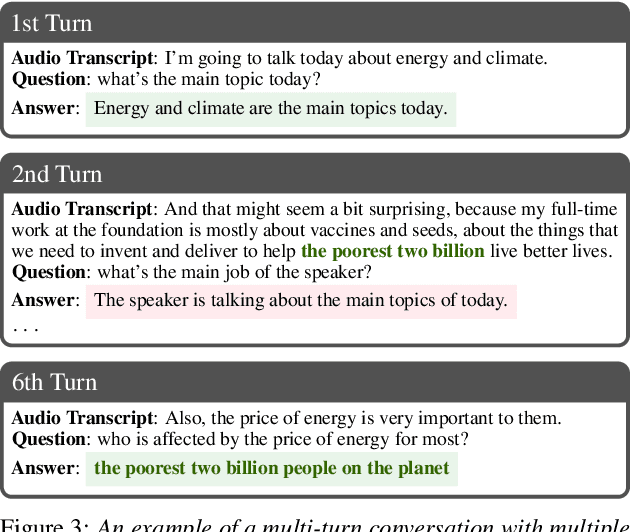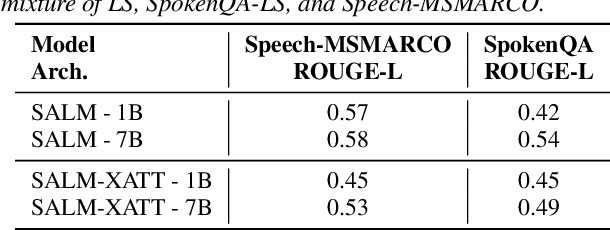Somshubra Majumdar
OpenCodeReasoning: Advancing Data Distillation for Competitive Coding
Apr 02, 2025Abstract:Since the advent of reasoning-based large language models, many have found great success from distilling reasoning capabilities into student models. Such techniques have significantly bridged the gap between reasoning and standard LLMs on coding tasks. Despite this, much of the progress on distilling reasoning models remains locked behind proprietary datasets or lacks details on data curation, filtering and subsequent training. To address this, we construct a superior supervised fine-tuning (SFT) dataset that we use to achieve state-of-the-art coding capability results in models of various sizes. Our distilled models use only SFT to achieve 61.8% on LiveCodeBench and 24.6% on CodeContests, surpassing alternatives trained with reinforcement learning. We then perform analysis on the data sources used to construct our dataset, the impact of code execution filtering, and the importance of instruction/solution diversity. We observe that execution filtering negatively affected benchmark accuracy, leading us to prioritize instruction diversity over solution correctness. Finally, we also analyze the token efficiency and reasoning patterns utilized by these models. We will open-source these datasets and distilled models to the community.
Scoring Verifiers: Evaluating Synthetic Verification in Code and Reasoning
Feb 19, 2025Abstract:Code verification has recently found great success as a critical component in training large scale reasoning models for coding. Synthetic techniques such as self-generated test cases and reward models provide a way to enhance code capabilities beyond predefined tests. Building on these advancements, we propose new benchmarks designed to systematically evaluate the impact of synthetic verification methods on assessing solution correctness. We introduce HE-R, HE-R+, MBPP-R, and MBPP-R+, which transform existing coding benchmarks into scoring and ranking datasets to evaluate the effectiveness of synthetic verifiers. Using these benchmarks, we analyze synthetic verification methods in standard, reasoning-based, and reward-based LLMs. Our results show that recent reasoning models significantly improve test case generation and that scaling test cases enhances verification accuracy.
Resource-Efficient Adaptation of Speech Foundation Models for Multi-Speaker ASR
Sep 02, 2024
Abstract:Speech foundation models have achieved state-of-the-art (SoTA) performance across various tasks, such as automatic speech recognition (ASR) in hundreds of languages. However, multi-speaker ASR remains a challenging task for these models due to data scarcity and sparsity. In this paper, we present approaches to enable speech foundation models to process and understand multi-speaker speech with limited training data. Specifically, we adapt a speech foundation model for the multi-speaker ASR task using only telephonic data. Remarkably, the adapted model also performs well on meeting data without any fine-tuning, demonstrating the generalization ability of our approach. We conduct several ablation studies to analyze the impact of different parameters and strategies on model performance. Our findings highlight the effectiveness of our methods. Results show that less parameters give better overall cpWER, which, although counter-intuitive, provides insights into adapting speech foundation models for multi-speaker ASR tasks with minimal annotated data.
Genetic Instruct: Scaling up Synthetic Generation of Coding Instructions for Large Language Models
Jul 29, 2024



Abstract:Large Language Models (LLMs) rely on instruction samples for alignment, but creating these datasets poses challenges, particularly in expert-dependent tasks like coding, which can be cost-prohibitive. One approach to mitigate these challenges is synthesizing data using another LLM. In this paper, we introduce a scalable method for generating synthetic instructions to enhance the code generation capability of LLMs. The proposed algorithm, Genetic-Instruct, mimics evolutionary processes, utilizing self-instruction to create numerous synthetic samples from a limited number of seeds. Genetic-Instruct is designed for efficient scaling of the generation process. Fine-tuning multiple coding LLMs with the synthetic samples demonstrates a significant improvement in their code generation accuracy compared to the baselines.
Less is More: Accurate Speech Recognition & Translation without Web-Scale Data
Jun 28, 2024Abstract:Recent advances in speech recognition and translation rely on hundreds of thousands of hours of Internet speech data. We argue that state-of-the art accuracy can be reached without relying on web-scale data. Canary - multilingual ASR and speech translation model, outperforms current state-of-the-art models - Whisper, OWSM, and Seamless-M4T on English, French, Spanish, and German languages, while being trained on an order of magnitude less data than these models. Three key factors enables such data-efficient model: (1) a FastConformer-based attention encoder-decoder architecture (2) training on synthetic data generated with machine translation and (3) advanced training techniques: data-balancing, dynamic data blending, dynamic bucketing and noise-robust fine-tuning. The model, weights, and training code will be open-sourced.
Instruction Data Generation and Unsupervised Adaptation for Speech Language Models
Jun 18, 2024



Abstract:In this paper, we propose three methods for generating synthetic samples to train and evaluate multimodal large language models capable of processing both text and speech inputs. Addressing the scarcity of samples containing both modalities, synthetic data generation emerges as a crucial strategy to enhance the performance of such systems and facilitate the modeling of cross-modal relationships between the speech and text domains. Our process employs large language models to generate textual components and text-to-speech systems to generate speech components. The proposed methods offer a practical and effective means to expand the training dataset for these models. Experimental results show progress in achieving an integrated understanding of text and speech. We also highlight the potential of using unlabeled speech data to generate synthetic samples comparable in quality to those with available transcriptions, enabling the expansion of these models to more languages.
Nemotron-4 340B Technical Report
Jun 17, 2024



Abstract:We release the Nemotron-4 340B model family, including Nemotron-4-340B-Base, Nemotron-4-340B-Instruct, and Nemotron-4-340B-Reward. Our models are open access under the NVIDIA Open Model License Agreement, a permissive model license that allows distribution, modification, and use of the models and its outputs. These models perform competitively to open access models on a wide range of evaluation benchmarks, and were sized to fit on a single DGX H100 with 8 GPUs when deployed in FP8 precision. We believe that the community can benefit from these models in various research studies and commercial applications, especially for generating synthetic data to train smaller language models. Notably, over 98% of data used in our model alignment process is synthetically generated, showcasing the effectiveness of these models in generating synthetic data. To further support open research and facilitate model development, we are also open-sourcing the synthetic data generation pipeline used in our model alignment process.
Stateful Conformer with Cache-based Inference for Streaming Automatic Speech Recognition
Jan 11, 2024Abstract:In this paper, we propose an efficient and accurate streaming speech recognition model based on the FastConformer architecture. We adapted the FastConformer architecture for streaming applications through: (1) constraining both the look-ahead and past contexts in the encoder, and (2) introducing an activation caching mechanism to enable the non-autoregressive encoder to operate autoregressively during inference. The proposed model is thoughtfully designed in a way to eliminate the accuracy disparity between the train and inference time which is common for many streaming models. Furthermore, our proposed encoder works with various decoder configurations including Connectionist Temporal Classification (CTC) and RNN-Transducer (RNNT) decoders. Additionally, we introduced a hybrid CTC/RNNT architecture which utilizes a shared encoder with both a CTC and RNNT decoder to boost the accuracy and save computation. We evaluate the proposed model on LibriSpeech dataset and a multi-domain large scale dataset and demonstrate that it can achieve better accuracy with lower latency and inference time compared to a conventional buffered streaming model baseline. We also showed that training a model with multiple latencies can achieve better accuracy than single latency models while it enables us to support multiple latencies with a single model. Our experiments also showed the hybrid architecture would not only speedup the convergence of the CTC decoder but also improves the accuracy of streaming models compared to single decoder models.
Investigating End-to-End ASR Architectures for Long Form Audio Transcription
Sep 20, 2023Abstract:This paper presents an overview and evaluation of some of the end-to-end ASR models on long-form audios. We study three categories of Automatic Speech Recognition(ASR) models based on their core architecture: (1) convolutional, (2) convolutional with squeeze-and-excitation and (3) convolutional models with attention. We selected one ASR model from each category and evaluated Word Error Rate, maximum audio length and real-time factor for each model on a variety of long audio benchmarks: Earnings-21 and 22, CORAAL, and TED-LIUM3. The model from the category of self-attention with local attention and global token has the best accuracy comparing to other architectures. We also compared models with CTC and RNNT decoders and showed that CTC-based models are more robust and efficient than RNNT on long form audio.
Fast Conformer with Linearly Scalable Attention for Efficient Speech Recognition
May 19, 2023



Abstract:Conformer-based models have become the most dominant end-to-end architecture for speech processing tasks. In this work, we propose a carefully redesigned Conformer with a new down-sampling schema. The proposed model, named Fast Conformer, is 2.8x faster than original Conformer, while preserving state-of-the-art accuracy on Automatic Speech Recognition benchmarks. Also we replace the original Conformer global attention with limited context attention post-training to enable transcription of an hour-long audio. We further improve long-form speech transcription by adding a global token. Fast Conformer combined with a Transformer decoder also outperforms the original Conformer in accuracy and in speed for Speech Translation and Spoken Language Understanding.
 Add to Chrome
Add to Chrome Add to Firefox
Add to Firefox Add to Edge
Add to Edge